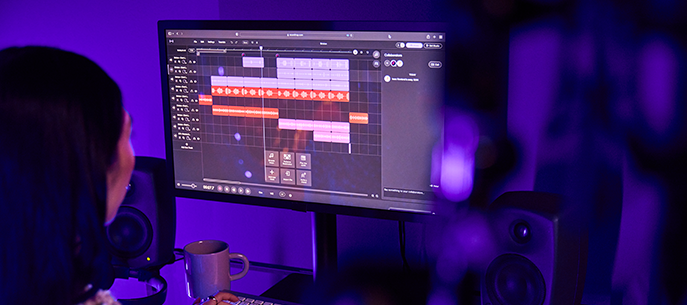
Beyond the Music: Top Soundtrap-Aligned Curricula for 2025
August 11, 2025You know that moment when a quiet student suddenly becomes the creative leader in your music class? We’ve seen it happen again and again when students get their hands on the right tools. Whether it’s a first-time beatmaker discovering rhythm or a budding songwriter finally recording their own lyrics, giving students authentic opportunities to create music transforms not just their skills, but their confidence.
Across districts, music educators are finding that integrating Soundtrap-aligned music curricula programs doesn’t just modernize instruction—it opens the door for deeper engagement, collaboration, and cross-curricular connections. From virtual ensembles to hip-hop production to culturally responsive songwriting, these programs show what’s possible when technology meets artistry in a standards-driven way.
Let’s be real about the challenge: You want to help students compose, collaborate, and produce music at a high level, but you don’t have time to piece together lessons from scratch—or the budget for endless hardware.
Here’s the solution: These top Soundtrap-powered music curricula take the guesswork out of integrating music technology into your program while staying true to your teaching style.
Want inspiration on using Soundtrap beyond music? Check out our Cross-Curricular Podcasting guide.
Why Soundtrap is Your Music Program’s Secret Weapon
Browser-based, anywhere collaboration. Your students can compose and produce together whether they’re in the same room or across town. No USB drives, no “I forgot my file at home.”
Authentic tools with an accessible learning curve. Students start with loop-based creation and templates, then grow into full multi-track production—without you needing weeks of PD.
Everything you need, nothing you don’t. From a royalty-free sound library to built-in autotune and MIDI compatibility, Soundtrap removes tech barriers so you can focus on teaching.
Not sure where to start? Our Beginner’s Guide to the DAW walks you and your students through your first session.
Jump to Section
- Young Producers Group: Music Production 1
- Soul Science Lab: Soundtrack ’63 EDU
- Electronic Music Elements
- Production Through Performance
- Light the Music: Virtual Ensembles
- Take Me to the River Education Initiative
- Building Beats
- Musikkpedagogikk Lesson Plans
- Quick Comparison Table
- Your Music Launch Strategy
- FAQ
Top Soundtrap-Aligned music curricula
1. Young Producers Group: Music Production 1
Grades: 4–12
Format: Year-long CTE-aligned course with teacher handbook, assignments, and music appreciation units
The official Soundtrap curriculum partner, Young Producers Group offers a turnkey program that walks students through beat-making, chords, melodies, and full-track production. Includes ready-to-use assignments, rubrics, and pacing guides, plus a music appreciation component for analyzing popular songs. Meets California Arts Standards and UC A–G credit requirements.
What teachers love: Complete structure and standards alignment make it easy to implement, even for educators with minimal production experience.
Best for: Schools launching an entry-level music tech or CTE program.
2. Soul Science Lab: Hip-Hop Songwriting & Production
Grades: 6–12+
Format: Self-paced masterclasses with culturally responsive lesson content
Combining hip-hop artistry with academic rigor, these courses guide students through writing, producing, and performing original hip-hop tracks. Lessons include historical context, companion worksheets, and culturally relevant discussion prompts to help students explore identity and purpose in their music.
What teachers love: The blend of cultural studies with music production skills.
Best for: Middle/high school programs focused on culturally responsive pedagogy.
3. Electronic Music Elements
Grades: 4–12
Format: Modular lesson sequences with teacher guides and hands-on projects
Electronic Music Elements bridges the gap between traditional music classes and industry-standard production. Includes sequenced lessons, video walkthroughs, and an optional educator workshop to help teachers build confidence in guiding DAW-based projects.
What teachers love: Adaptability for different schedules and ability levels.
Best for: Schools seeking a flexible, skill-building music tech program.
See it in action: Read how one teacher went from no music tech experience to transforming student lives in our Electronic Music Elements success story.
4. Production Through Performance
Grades: 7–12
Format: Flipped-classroom curriculum with 28 projects across six units
Students learn to write and record drum beats, bass lines, chord progressions, and melodies using Soundtrap. Includes videos, graphic organizers, rubrics, and self-assessment tools. Designed for an 18-week semester but easily adaptable.
What teachers love: Structured, repeatable projects and strong assessment tools.
Best for: Performance-based music tech classes.
5. Light the Music: Virtual Ensembles
Grades: 7–12
Format: Project-based ensemble creation using Soundtrap
Students work in small “bands” to create original compositions, learning rhythm, bass, melody, and form in the process. Includes facilitation guides, assessment rubrics, and Soundtrap project templates. Professional development available for teachers.
What teachers love: Fosters collaboration while building DAW skills.
Best for: Hybrid or virtual music programs.
6. Take Me to the River: New Orleans Curriculum
Grades: 9–12
Format: Five units combining music history, listening, and production projects
Students explore New Orleans’ musical heritage through hands-on Soundtrap projects—arranging, remixing, and creating original compositions inspired by genres like jazz, brass band, and Mardi Gras Indian traditions.
What teachers love: The rich cultural and historical integration.
Best for: Cross-curricular history and music programs.
7. Building Beats: DJ & Beat-Making Programs
Grades: 6–12+
Format: Community-based programs focusing on music production and entrepreneurship
Building Beats uses Soundtrap to teach DJing and beat production while also building students’ leadership and entrepreneurial skills. Programs are designed for both in-school and out-of-school contexts.
What teachers love: Blends creative expression with career skills.
Best for: After-school and community programs.
8. Musikkpedagogikk: Free Nordic Lesson Plans
Grades: Various
Format: Nine downloadable Soundtrap lesson plans
These free lesson plans range from beginner to advanced, with activities tailored for different age groups. Each includes step-by-step instructions and can be adapted for multiple contexts.
What teachers love: Free, ready-to-use resources.
Best for: Teachers experimenting with Soundtrap for the first time.
Quick Soundtrap-Aligned Music Curricula Comparison Table
| Curriculum | Grades | Time Investment | Format / Focus | Best For |
|---|---|---|---|---|
| Young Producers Group | 4–12 | Year-long | CTE-aligned production course | Entry-level music tech |
| Soul Science Lab | 6–12+ | Self-paced | Hip-hop songwriting & production | Culturally responsive units |
| Electronic Music Elements | 4–12 | Flexible | Modular music tech lessons | Adaptable programs |
| Production Through Performance | 7–12 | 18 weeks | Flipped-classroom performance | Performance + production |
| Light the Music | 7–12 | Multi-week | Virtual ensemble projects | Hybrid/virtual ensembles |
| Take Me to the River | 9–12 | 5 units | History + production | Cross-curricular |
| Building Beats | 6–12+ | Ongoing | DJ + entrepreneurship | Community programs |
| Musikkpedagogikk | Various | Single lessons | Free downloadable plans | First-time Soundtrap users |
Your Music Launch Strategy: Start Small, Think Big
Ready to amplify student creativity through music? Here’s an actionable plan to get started:
1. Pick a pilot curriculum. Choose one program from above that matches your students’ needs and your teaching goals. Focus on implementing it well rather than overhauling everything at once.
2. Connect projects to standards. Align your chosen program with district or state music standards—composition, collaboration, cultural literacy—so student work clearly ties to learning goals.
3. Document and share. Save student compositions, project reflections, and collaboration examples. Share with parents, administrators, and your school board to highlight the impact of music technology.
4. Expand intentionally. After one success, explore integrating other programs—such as pairing hip-hop songwriting with history or adding a virtual ensemble to your band program.
Remember: you don’t have to be a professional producer to help students create professional-sounding work. With the right curriculum and tools like Soundtrap, students will surprise you with their creativity and skill.
FAQ
Q: What are the benefits of using Soundtrap-aligned music curricula for students?
A: Students gain creativity, problem-solving, collaboration, and digital literacy skills. They also build confidence by sharing their work in authentic contexts.
Q: How can I integrate Soundtrap into my existing curriculum?
A: Start small—use a ready-to-go lesson or unit from one of these programs. Many include templates, rubrics, and pacing guides to make integration seamless.
Q: Do I need special equipment?
A: No. Soundtrap works on any internet-connected device with a basic microphone (often the built-in one). Students can collaborate and create from anywhere without extra hardware.
Want to see these curricula in action? Explore Soundtrap for Education’s blog for teacher stories, lesson ideas, and more inspiration.
 EDU Portal
EDU Portal


